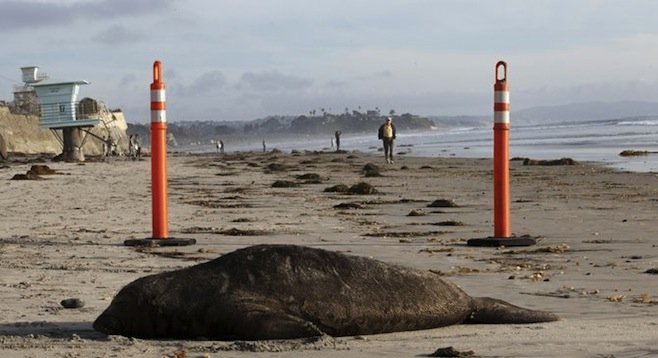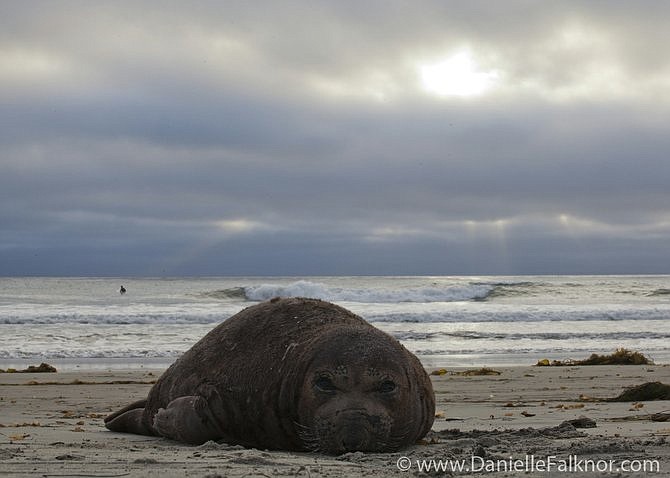 Facebook
Facebook
 X
X
 Instagram
Instagram
 TikTok
TikTok
 Youtube
Youtube

Early on Sunday morning, March 2, after a storm had passed, I ran past a little seal sleeping on the beach in Cardiff by the Sea. He looked really tired and even though he was breathing rapidly and sometimes coughing, he wasn't trying to get back into the water.
He looked distressed and a bit frightened. So, I was a little perplexed, as I had never seen one before and had no idea what I should do. Should I call someone and stay to make sure he’s okay?
I’d just about made my decision to continue my run and swing back again later to check on him when I saw a family walk up to him and try to touch him, posing for photographs. The little guy raised his head and gave a frightened bellow, shifting his body away, trying to protect himself.
I lost my temper — swung around and immediately told them off for getting too close to him and asked them to step away. Thankfully, I was not alone. Two guys with a dog stopped to join in, and a runner named Mike, who works for Project Wildlife, stopped to help guard the seal, too. We all stood with the pup as the sun went down, determined not to move until the beach emptied of people or the authorities arrived.
The Coast Guard eventually arrived and told us the seal wasn’t injured or sick, just tired, so it was safe to leave him with them.

Eight days later, the seal is still on the beach! I go for a walk every day to check on him and sometimes to sit three meters away, watching him sleep and taking pictures. People come by who are curious about him, asking questions and offering assistance. A lot of locals and volunteers have been taking turns to look out for him. Mike came around (again, after a run) and gave me an update, too.
According to the local volunteers, SeaWorld — the only seal rescue center in California — has been out to observe the seal a few times and declared that he was healthy, around 2.5 months old, and that it was a girl. They assured the volunteers that this process she’s going through is completely normal.
“When young seals grow to a certain age, their mothers abandon them and leave them on a beach to shed their fur and puppy fat, ready to join the adults,” Mike explained. “This process can take up to a couple of weeks, and so we should leave her alone. If we try and put her back in the water at this stage, chances are she will drown.”
SeaWorld suggested that she got lost, washed up on the beach during the storm, and was too weak to try and reach its group.

“She’s all right,” local volunteer Judi said. “She’ll stick around here for another week or so; then she’ll leave to go hunting for fish. Until then, we’ll be here to keep an eye on her.”
The only worry that many of the volunteers have is how many people are getting too close to her.
“This is a public beach and so we can’t stop people from coming down here, but it’s not possible to be watching all the time,” said Judi. “We’ve put orange pylons out here to make people aware, but people are still get too close to her. Just this morning, a bunch of kids were jumping over her and going up and touch her. Who are these parents that are letting their children do this? These are wild animals and she will bite you if you get too close. Not to mention the poor thing must be scared out of her mind.”


Early on Sunday morning, March 2, after a storm had passed, I ran past a little seal sleeping on the beach in Cardiff by the Sea. He looked really tired and even though he was breathing rapidly and sometimes coughing, he wasn't trying to get back into the water.
He looked distressed and a bit frightened. So, I was a little perplexed, as I had never seen one before and had no idea what I should do. Should I call someone and stay to make sure he’s okay?
I’d just about made my decision to continue my run and swing back again later to check on him when I saw a family walk up to him and try to touch him, posing for photographs. The little guy raised his head and gave a frightened bellow, shifting his body away, trying to protect himself.
I lost my temper — swung around and immediately told them off for getting too close to him and asked them to step away. Thankfully, I was not alone. Two guys with a dog stopped to join in, and a runner named Mike, who works for Project Wildlife, stopped to help guard the seal, too. We all stood with the pup as the sun went down, determined not to move until the beach emptied of people or the authorities arrived.
The Coast Guard eventually arrived and told us the seal wasn’t injured or sick, just tired, so it was safe to leave him with them.

Eight days later, the seal is still on the beach! I go for a walk every day to check on him and sometimes to sit three meters away, watching him sleep and taking pictures. People come by who are curious about him, asking questions and offering assistance. A lot of locals and volunteers have been taking turns to look out for him. Mike came around (again, after a run) and gave me an update, too.
According to the local volunteers, SeaWorld — the only seal rescue center in California — has been out to observe the seal a few times and declared that he was healthy, around 2.5 months old, and that it was a girl. They assured the volunteers that this process she’s going through is completely normal.
“When young seals grow to a certain age, their mothers abandon them and leave them on a beach to shed their fur and puppy fat, ready to join the adults,” Mike explained. “This process can take up to a couple of weeks, and so we should leave her alone. If we try and put her back in the water at this stage, chances are she will drown.”
SeaWorld suggested that she got lost, washed up on the beach during the storm, and was too weak to try and reach its group.

“She’s all right,” local volunteer Judi said. “She’ll stick around here for another week or so; then she’ll leave to go hunting for fish. Until then, we’ll be here to keep an eye on her.”
The only worry that many of the volunteers have is how many people are getting too close to her.
“This is a public beach and so we can’t stop people from coming down here, but it’s not possible to be watching all the time,” said Judi. “We’ve put orange pylons out here to make people aware, but people are still get too close to her. Just this morning, a bunch of kids were jumping over her and going up and touch her. Who are these parents that are letting their children do this? These are wild animals and she will bite you if you get too close. Not to mention the poor thing must be scared out of her mind.”
Comments